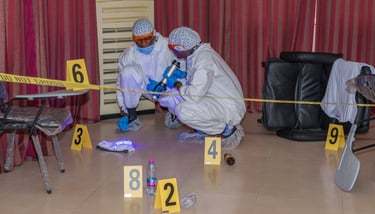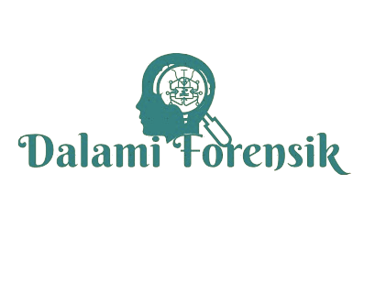Forensic Science: An Introduction
TOPICS IN FORENSICS


The word “forensic” is derived from the Latin word “forensis” which means something related to a gathering or forum.
Source: Forensic Science Department, University of Cape Coast – Ghana
Introduction
The word “forensic” is derived from the Latin word “forensis” which means something related to a gathering or forum. Recently, forensics have been widely used to indicate anything related to the court or the legal system. Science is a human effort that attempts to understand and explain the natural world through experimentation and observations. Scientific knowledge and technology continue to play a vital role in regulating human activities.
Forensic science is the application of scientific knowledge and techniques to civil and criminal laws enforced by police agencies in the criminal justice system. Forensic science can be referred to as a court or investigative science because it often involves the application of science to law.
Need for Forensic Science
The fundamental role of forensic science is to support the criminal justice system by providing hard facts and evidence, based on scientific knowledge and principles. Often, what we thought we heard, saw or felt might not be true; hence, there is a need to investigate and validate any crucial piece of information that is largely based on our senses (perceptions). In addition, the rise in the sophistication of crime commission by criminals calls for the need to employ advanced scientific ways of mitigating crimes and apprehending offenders. It is easy for an eyewitness to attempt to sway a legal decision by providing inaccurate accounts of events; however, forensic evidence will always seek and stick to the objective truth. As usually said in the case of fingerprint evidence, “fingerprints cannot lie, but liars can make fingerprints”.
Archimedes & The Gold Crown
In the 1st century BCE, Roman author and architect Vitruvius relayed the story of how Archimedes detected fraud in the manufacturing of a gold crown commissioned by King Hiero II. Archimedes' investigation of whether the crown of the king was purely made of pure gold is a good illustration of the application of science to a legal issue. Archimedes applied the scientific principles of buoyancy and density to detect that the crown was not purely made of gold, indicating that the goldsmiths mixed (alloyed) the gold with other cheap metal(s) in an attempt to defraud the king. The goldsmith confessed to his crime and was punished by the king 2,3.
Evolution
Forensic science has evolved over the years, dating back to 1000 BCE, when the Chinese used fingerprints to sign legal documents. The works of Sir Francis Galton on fingerprints in 1892, the discovery of the ABO blood typing system by Karl Landsteiner in 1901, the setting up of the first forensic science laboratory in France by Edmund Locard in 1910, the discovery of the double helical structure of DNA by James Watson and Francis Crick in 1953, the development of the DNA “fingerprint” technique by Sir Alec Jeffreys in 1984, among many others, contributed significantly to present and modern forensic science.
Additionally, the fictional writing of Sung Tzu in 1247, a book titled “The Washing Away of Wrongs”, is usually cited as one of the earliest depictions of forensic entomology. The Sherlock Holmes novel by Sir Arthur Conan Doyle in 1887 contributed to the popularization of forensic science. Crime Scene Investigation (CSI) shows such as Criminal Minds, CSI, Dexter, NCIS, Flash, Sherlock Holmes, and true crime documentaries like Forensic Files, have drawn significant attention, appreciation, and admiration for the field of forensic science.
In addition, high-profile cases, including those of O. J. Simpson, Ted Bundy, Brandon Mayfield, and Lindbergh kidnapping among others, drew a lot of public attention and media coverage. The role of forensic science in these cases increased its already growing fame and prominence.
CSI Effect
The “CSI effect” is sometimes referred to as the “CSI syndrome”. It is the unrealistic expectation of forensic science by the general public and jury in real-life cases due to impressions they have obtained from fictional movies and novels. Crime scene films are usually dramatized and intended to appeal to the viewers more often that they do not abide by the realities of forensic science 1. This has become challenging for real court cases, especially for individuals with stakes in a particular case yet are unable to differentiate between CSI film effects, which are usually exaggerations of forensic science capabilities, and real-life (practical) applications of forensic science.
A movie scenario could be a crime officer uploading a portion of recovered fingerprints on a fingerprint database which instantly provides an information of a suspect within a few seconds. However, in reality, identifying a suspect by a fingerprint can take weeks to months, and the procedure always require a manual examination by a fingerprint expert.
The CSI effect has made the public and the jury believe that forensic science can solve all cases in a short time, even though it is far from reality. There are studies suggesting that legal actors perceive the CSI effect as a serious issue, although there is no empirical evidence supporting the phenomenon yet.
Branches of Forensic Science
Forensic science has diverse branches and sub-branches; however, it can be broadly grouped into three major branches:
Forensic chemistry: This field applies knowledge of chemistry to answer legal questions. It includes the analysis of narcotics, poisons (toxicology), fires, explosives, etc.
Forensic biology: This field applies biological knowledge and understanding to the criminal justice system. It includes DNA analysis, forensic pathology, forensic anthropology, forensic botany, etc.
Forensic physics: This is the study and application of the knowledge and laws of physics to legal matters. It involves areas such as forensic ballistics, blood pattern analysis (BPA), fingerprint analysis, glass and fibre analysis, computer forensics, forensic photography, etc.
The fields of forensic science are broad and diverse, and a particular subfield may require a multidisciplinary approach. It is common to come across disciplines such as forensic psychology, forensic auditing and accounting, and forensic art, which are applications of social science, business, and art respectively to solve legal issues. This indicates that forensics is an all-encompassing term that can be applied to almost all domains within and beyond the natural sciences.
Modern Trends
The field of forensics is continuously growing and evolving with the development of modern techniques and approaches, as well as the exploration and harnessing of existing techniques from other domains. Below are a few examples of relatively new and emerging trends in forensic science.
Forensic genetic genealogy: This field of forensic science deals with the application of knowledge of genealogy to settle legal disputes. Suspects are identified through distant relatives using family trees and genealogy databases.
Multimedia forensics: This field focuses on enhancing digital media (files). For example, enhancing blurred inscriptions in an image or video. Additionally, it enables the verification and authentication of the origin and/or chain of transmission of digital media. The field also includes voice-print analysis and speaker recognition among many others.
Molecular fingerprinting: This technique examines fingerprints beyond the ridge pattern and seeks to determine certain characteristic features of the fingerprint donor, such as health status, diet, and lifestyle, using mass spectrometry.
3D forensics: This involves the application of knowledge of 3D scanning and printing to help reconstruct a crime scene or evidence. The 3D scanning of a crime scene helps preserve the originality of the scene for future use and aids in crime scene reconstruction and re-enactment.
Case Study - The Hitler Diaries
In 1983, a news magazine published excerpts of documents purported to be handwritten diaries of Adolf Hitler, which were reportedly lost during an aeroplane crash in 1945. A small piece of the diary was preliminarily examined by some historians and confirmed to be accurate and genuine. The copies of the diaries provided by an antique dealer Konrad Kujau were worth millions of dollars. A further detailed forensic examination of the documents revealed inconsistencies between the purported Hitler diaries and his known handwriting. Also, some chemical constituents were found within the ink and paper of the alleged diaries which were non-existent during Hitler’s lifetime. Therefore, forensic examination revealed that the diaries were forged and not genuine.
Konrad Kujau, a man with a long history of counterfeiting and selling fake memorabilia, later confessed to forging the Hitler diaries and hence was sentenced to prison. He had studied Hitler’s handwriting from various sources and made the forged diaries appear as old documents by exposing them to various chemical and mechanical processes.
Conclusion
Forensic science has revolutionized the field of crime-solving and investigation. It has unravelled thousands of unknown mysteries. With increasing sophisticated crime methods, forensic science will continue to play a pivotal role within the criminal justice system. And always keep in mind that, the absence of evidence is not evidence of absence, as Carl Sagan once remarked.
References
Saferstein R. Criminalistics An Introduction to Forensic Science.; 2018. https://lccn.loc.gov/2016036756
The Golden Crown. Accessed September 18, 2024. https://physics.weber.edu/carroll/archimedes/crown.htm
Archimedes and the Golden Crown — Long long time ago. Accessed September 19, 2024. https://www.longlongtimeago.com/once-upon-a-time/great-discoveries/archimedes-and-the-golden-crown
ChinJM,WorkewychL.TheCSIEffect. http://ssrn.com/abstract=2752445Electroniccopyavailableat:https://ssrn.com/abstract=2752445Electroniccopyavailableat:http://ssrn.com/abstract=27524452
The Hitler Diaries – The Forensics Library. Accessed September 18, 2024. https://aboutforensics.co.uk/the-hitler-diaries/
